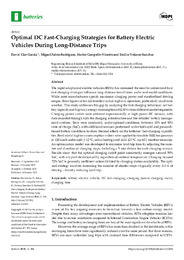Por favor, use este identificador para citar o enlazar este ítem:
https://hdl.handle.net/11000/38108Registro completo de metadatos
| Campo DC | Valor | Lengua/Idioma |
|---|---|---|
| dc.contributor.author | Clar García, David | - |
| dc.contributor.author | Fabra Rodríguez, Miguel | - |
| dc.contributor.author | Campello Vicente, Héctor | - |
| dc.contributor.author | Velasco Sánchez, Emilio | - |
| dc.contributor.other | Departamentos de la UMH::Ingeniería Mecánica y Energía | es_ES |
| dc.date.accessioned | 2025-11-11T10:35:11Z | - |
| dc.date.available | 2025-11-11T10:35:11Z | - |
| dc.date.created | 2025 | - |
| dc.identifier.citation | Batteries | es_ES |
| dc.identifier.issn | 2313-0105 | - |
| dc.identifier.uri | https://hdl.handle.net/11000/38108 | - |
| dc.description.abstract | The rapid adoption of electric vehicles (BEVs) has increased the need to understand how fast-charging strategies influence long-distance travel times under real-world conditions. While most manufacturers specify maximum charging power and standardized driving ranges, these figures often fail to reflect actual highway operation, particularly in adverse weather. This study addresses this gap by analyzing the fast-charging behaviour, net battery capacity and highway energy consumption of 62 EVs from different market segments. Charging power curves were obtained experimentally at high-power DC stations, with data recorded through both the charging infrastructure and the vehicles’ battery management systems. Tests were conducted, under optimal conditions, between 10% and 90% state of charge (SoC), with additional sessions performed under both cold and preconditioned battery conditions to show thermal effects on the batteries’ fast-charging capabilities. Real-world highway consumption values were applied to simulate 1000 km journeys at 120 km/h under cold (−10 °C, cabin heating) and mild (23 °C, no AC) weather scenarios. An optimization model was developed to minimize total trip time by adjusting the number and duration of charging stops, including a 5 min detour for each charging session. Results show that the optimal charging cutoff point consistently emerges around 59% SoC, with a typical deviation of 10, regardless of ambient temperature. Charging beyond 70% SoC is generally inefficient unless dictated by charging station availability. The optimal strategy involves increasing the number of shorter stops—typically every 2–3 h of driving—thereby reducing total trip. | es_ES |
| dc.format | application/pdf | es_ES |
| dc.format.extent | 19 | es_ES |
| dc.language.iso | eng | es_ES |
| dc.publisher | MDPI | es_ES |
| dc.relation.ispartofseries | Vol. 11 | es_ES |
| dc.relation.ispartofseries | nº 11 | es_ES |
| dc.rights | info:eu-repo/semantics/openAccess | es_ES |
| dc.rights | Attribution-NonCommercial-NoDerivatives 4.0 Internacional | * |
| dc.rights.uri | http://creativecommons.org/licenses/by-nc-nd/4.0/ | * |
| dc.subject | battery electric vehicle | es_ES |
| dc.subject | DC fast-charging | es_ES |
| dc.subject | charging power | es_ES |
| dc.subject | charging curve | es_ES |
| dc.subject | charging time | es_ES |
| dc.subject.other | CDU::6 - Ciencias aplicadas::62 - Ingeniería. Tecnología | es_ES |
| dc.subject.other | CDU::6 - Ciencias aplicadas::62 - Ingeniería. Tecnología::629 - Ingeniería de los vehículos de transporte | es_ES |
| dc.title | Optimal DC Fast-Charging Strategies for Battery Electric Vehicles During Long-Distance Trips | es_ES |
| dc.type | info:eu-repo/semantics/article | es_ES |
| dc.relation.publisherversion | https://doi.org/10.3390/batteries11110394 | es_ES |

Ver/Abrir:
Optimal DC Fast-Charging Strategies for Battery Electric Vehicles During Long-Distance Trips.pdf
1,65 MB
Adobe PDF
Compartir:
 La licencia se describe como: Atribución-NonComercial-NoDerivada 4.0 Internacional.
La licencia se describe como: Atribución-NonComercial-NoDerivada 4.0 Internacional.
.png)